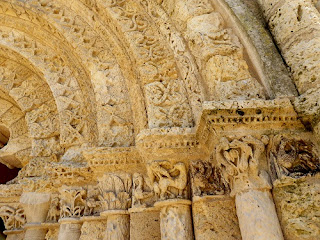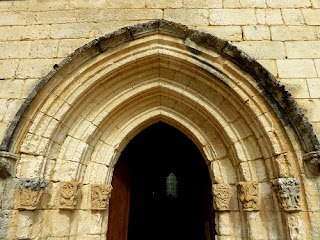Only a week to go now before our annual Norfolk Churches Walk, so time for a flashback to my first time in the Dordogne last month, a very happy one which let me see what all the fuss about this Herefordshire-on-steroids is all about. Said churches actually sit in different regions, but since the River Dronne is a natural boundary, let's stretch the geography a bit and make it the unifying factor. Unquestionably the two most spectacular are to be found in the perfect hill town of Aubeterre-sur-Dronne - the 11th century facade of the otherwise much-rebuilt St-Jacques pictured above, the town from the river below -
but the smaller gems are all singular. Since I had to leave the Itinéraire Baroque Festival on the morning of its musical church-crawl - for a wedding in a very English church - I asked Gabriel Fysh, who'd volunteered to be our driver and cicerone, if we could ditch the planned excursion to Brantôme, fascinating though that place sounds, and explore more locally instead.
Not far from our base in Riberac, we stopped at Coutures. Astonishingly, I can find nothing at all online about the Romanesque church. Nor is there a single guide to the churches of the area, or leaflets inside the churches (30-plus served by the same priest), and three don't even get a mention in my Blue Guide. Even Gabriel had not gone to the exterior of the east end where there's a fascinating corbel table not unlike that of Kilpeck.
The inside is interesting, too, not least because it's possible to see where the original garrison-church stopped to accommodate the soldiers' quarters above. The vaults of several churches were added later in converting the building as a whole.
Next stop Saint-Martial-Viveyrol, with very photogenic sunflower fields on the outskirts. Gabriel, whose family has cultivated a large walnut grove adjacent to their house, sighed to say that the local farmers grow nothing other than sunflowers and maize in the summer; few are interested in going back to the more fruitful old ways.
Was St-Martial on the Chemin/Camino to Santiago? The scallop of St James on the font suggests as much.
Its domes are impressive - I'm assuming this wasn't a garrison like several of the others -
and there are some interesting heads on the capitals.
Outside it looks massy-proof
as does the church at Cherval,
the most imposing in its setting at the top of the hill. From below you can see more clearly the barracks above, which in this instance have not been converted.
Lusignac, the local for Gabriel's family, has the church with the most colourful interior design, as you can immediately see approaching via the wooden-roofed porch.
Major Virgin activity here
It's in another fine setting next to a curious castle
and a perfectly-situated tavern with a great view on to the surrounding landscape.
Then it was time to meet up with the other Fyshes and friends for a delicious dip in the river (the Vonnegut 'if this isn't nice, what is?' needed to be invoked)
before we parted company again and Gabriel dropped the remaining three of us in Aubeterre. Down by the Dronne I found more dragonflies and damselflies, even catching this one briefly settled.
I had been a bit suspicious of the inaccurately-named 'monolithic church' of StJean - it's more accurately a cave church - and its (shock, horror!) admission charge,
but once inside, stunned by the scale of it, I could see why it would have been worth twice the entry fee. Hewn out of the rock by Benedictine monks in the 12th century, used for burials up to 1865 and then concealed by a rockfall until the 1950s, it's the largest subterranean (can one say interranean?) church in Europe.
Connections with the Crusades include the housing of relics from Jerusalem at various points of what even for the present-day visitor is something of an adventure. The Holy Sepulchre was the model for this Romanesque reliquary.
Twenty metres high, the nave adjoins a necropolis
and offers access to the gallery above (you are asked to keep silence, not so easy for visiting summer families, but then the place was hardly overrun).
After lunch on a terrace looking over to the other part of town, we sweltered even walking the short distance uphill, and keeping to the shade as we did so, to St-Jacques. The central portal of its Romanesque facade is certainly the most elaborate
but there are splendid zodiacal panels matching labours to the times of year above the left door.
Our festival base of St-Cybard, located in flatter territory but with a pleasing end-of-the-world feel to it,
also boasts a fine doorway
and the carvings on its capitals feature many green men.
I got very overheated taking a short afternoon walk into La Tour-Blanche, chiefly to get a much-needed espresso, though poking around its ruined castle was worth it.
It gives one the creeps, not least because I'd just heard that the old couple who lived there until last year had burnt to death; it awaits a takeover, but in the meantime there traces of the recent life and also a fair bit of charring. Anyway, St-Cybard's setting is idyllic, especially in the evening.
The churchyard overlooks a valley with another church just visible among the trees on the opposite side.
On the first evening, the moon rising already seemed to promise orangey hints of the eclipse to come,
but it was hidden behind clouds on the night in question, even if that did include a spectacular sunset on the other side
and the wait did, as I showed in my most recent Pärnu blog, yield the first of my two summer hedgehogs. I left for Bordeaux airport in the rain which finally arrived the following morning well satisfied with the pleasures of this brief excursion.





























































6 comments:
Your tour of Dordogne churches reminds me of a long ago trip to that area of France. It all blends together now (I think we were part time in Languedoc and part time in Dordogne). I had a detailed guide of medieval villages in the area and in those days, unlike now, was determined to visit every one. It was a memorable trip, though now the villages we saw all run together in my mind. What I recall most is the way the late afternoon light washed all of those villages in shades of burnished gold.
I'm hoping for burnished gold on the Norfolk churches in the later stages of our imminent walk - the sublime early autummn weather is due to hold. The morning light here was very sharp and lovely, as you can see. Afternoons and evenings tended to be at Cercles for the concerts, and there's a pic of the west end of St-Cybard in just such a light on The Arts Desk.
Jung said, if the Christian religion is not true, it is certainly psychologically valid, since otherwise it would not have succeeded. Your continuing and lovely pictures of churches, and your delight in them, is in support of Jung
Thank you, David. No wonder visitors always write in the books 'very peaceful'. I see churches as quiet spaces for meditation, adorned with artist creativity on the highest level.
I see the Coutures to Killpeck similarity... A Sheela-n-gig! I didn't know they had them in France. I think they originated in Ireland? But maybe not? Sculptors probably travelled around quite a bit, so it's hard to know which direction the Sheela-na-gig went. They are pre-Christian I beleive.
Yes, I was going to comment on the Sheela-na-gig (a church in Hereford has what it calls a 'Bruce-na-gig' as a wry commentary on Kilpeck's Sheela. I've seen one somewhere else, too, forget where). Fertility symbols, I guess - there's so much continuity. Green men are pagan too, surely? Is that Deborah vdB?
Post a Comment